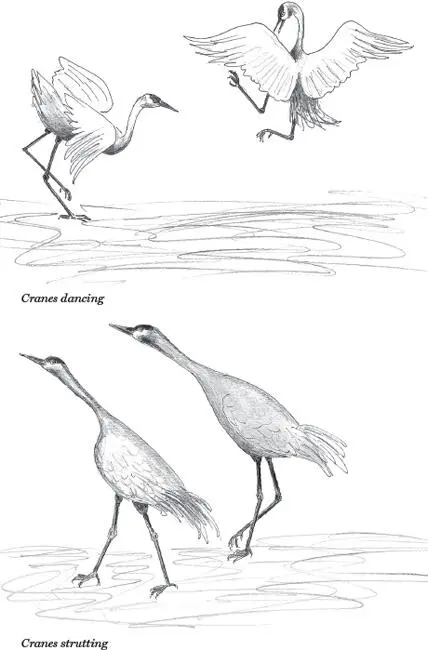I would have liked to fly with the cranes on their homeward journey, but the best I could do, apart from trying to beat them to their destination, was to see a piece of their flight path. My transcontinental flight of 3,872 kilometers from JFK Airport in New York was followed by a direct flight on April 23 from Seattle to Fairbanks, and I spent most of the three and a half hours of the 2,467-kilometer flight from Seattle north in the Boeing 737–800 with my face pressed to the window, trying to see like a crane. How did the cranes navigate and negotiate their five-thousand-kilometer journey from Texas or Mexico to come home to their own pingo out of thousands of others scattered throughout the vast and seemingly unending Alaskan taiga?
The cranes arrive lean at their main staging area, at the Platte River in Nebraska, and stay three weeks to gather reserves for their continuing journey north. When ready, they gather with thousands of others and wheel high in the sky into giant “chimneys,” to travel together on their common journey. Once in Alaska, they take separate paths to their individual homes, and a third of them fly beyond, to their homes in Siberia.
We had scarcely lifted off in Seattle when we passed over white-capped mountains with knife-edged ridges, dark forested valleys, and peninsulas surrounded by blue-gray water. An hour later, cruising at about eight hundred kilometers per hour at eleven thousand meters, there was ever more of the same — white mountains as far as the eye could see. Another hour — it was still the same. To me, barely a feature stood out from the jumble of endless peaks that melded into each other, and the vast mountain scape was broken only by frozen lakes glinting in the evening light. And so it continued for yet another hour. When we started our descent to Fairbanks, I saw oxbows of meandering rivers, and finally the thin thread of a road.
Cranes, swans, and geese travel south in the fall as family groups. On their way, the young learn the route they will later take north in the spring, to come back to try to settle near where they were born. What they see and remember seems astounding. I might, with intense concentration, memorize a tiny portion of the way, perhaps around this or over that mountain. But these cranes come not from my point of departure, the state of Washington, but from considerably farther south. (Four cranes from the Coldstream Valley that the Alaska Department of Fish and Game had equipped with radio transmitters ended up in various parts of Texas in the winter.) I could never retrace even my own much shorter flight route from Seattle, even if I were to return the day after having flown over it, much less a half-year later. What are the cognitive mechanisms that allow the birds to do this?
Day after day for almost eight months now there had been no crane at the pingo. For most of that time the ground had been under a deep layer of snow that locked any food out of reach. What would happen if, after their long-distance flying, the pair were to arrive at their home and find the bog still under snow and ice with no cranberries to be found and no voles to catch? How much can cranes afford to gamble in order to try to come on time, or even early?
It was only in the last week of April, after another snowstorm, that the weather suddenly warmed, and just then, on the 24th of April, on my first morning, we heard a crane in the distance. Still, no cranes landed on the pingo on the 25th, 26th, 27th. But the next morning at dawn I awoke to the loud and penetrating trumpeting calls of a single crane. These metallic sounds are unearthly; as Aldo Leopold wrote in his “Marshland Elegy,” they evoke “wildness incarnate.” On and on this bird shattered the dawn’s stillness, and I ran out to look. But the bird was then distant, and the sound kept shifting position, so I presumed it was flying around in great circles, possibly looking for a patch of cleared ground; the mossy floor of the nearby stunted spruce forest was still covered in deep snow.
That evening we sat down to supper by the window facing the wide-open panorama of the pingo in front of us. The sun was still high. We were just polishing off the last of our freshly grilled salmon when we looked up to see a crane with spread wings gliding down for a landing. Its long thin legs touched down gently on the still-thick ice of the pond. It bugled and sprang up half a meter or so, unfurling its long neck with beak held skyward and with extended wings at the apogee of its graceful leap as if to catch itself in the air to prolong this moment. It looked like a physical embodiment of joy and excitement. The crane kept leaping, all the while continuing its stirring bugling. Cranes don’t do this every time they land; this was indeed a special landing. Finishing its dance, the crane started to walk in a contrastingly slow and deliberate manner, thrusting its head forward and up with each step, and at the same time opening its bill and making a very different, trilling, call.
The crane walked and leaped in several more repetitions of its dance before eventually lifting off with even wing beats to sail off in the same direction from which it had come, its haunting cries growing faint in the distance. Two hours later the (same?) crane came again, but this time it circled the bog only once before leaving, continuing its calling. It had given the impression that it was glad to be back but was at the same time agitated and looking for something; a mate? In previous years Millie and Roy had always returned as a couple, George and Christy told me, so lacking positive identification, we were skeptical that this was either of them.
I had barely gone to bed that night when I heard another one or possibly two cranes calling excitedly, while a third seemed to answer from the distance. I jumped up and rushed outside to look: a pair were walking from one end of the bog to the other. George and Christy were up also, and for the next hour, until it got dark at 11:15 p.m., we watched. One of the cranes stood tall and extended his head and neck forward and up, reminding me of the dominance display of a male raven. This was Roy. The second one, whom I would soon identify by her walk and talk and narrower white face patch, held her neck and head in a more downward curve like a heron’s, projecting her head slightly forward with each step. She started to pick up cattail fronds and grasses and then to deposit them, sitting down briefly on the materials. Was she encouraging her mate by suggesting to him that it was time to start nesting at one or another of these potential nest sites? I could hardly wait to see what would happen next.

Crane pair coming home
Another clamor awoke me in the early dawn, around 4:00 a.m. There had been a heavy overnight frost and the two cranes were standing on the ice in the middle of the bog. Both Millie and Roy tossed their heads up in a quick motion, their bills opening wide during each call. We heard what sounded like a hammer hitting a metal bell or drum, as he opened his bill once to make each call and she chimed in at the same time but called and opened her bill twice to make two short similar cries of a higher pitch. It was a composite call made by both together; a duet. A third, distant crane responded. The distant calls, and the pair’s duet, were repeated back and forth, often and loudly.

The vigor of the pair’s unison calling was still palpable, even when the first morning light lit the sky and silhouetted the black spruces, and when I thought about the enormous effort they had invested to get here, I realized what was at stake: home ownership. The pair’s loud clanging calls attracted no others flying in from the distance; instead, the calls are a vocal “no trespassing” sign, one leaving no doubt that any potential challenger would be facing not just one bird, but a united, cooperating pair.
Читать дальше














